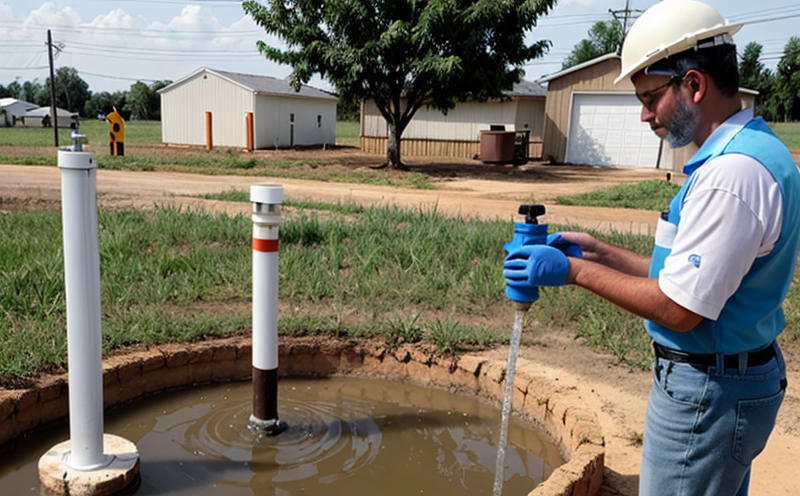ISO 7027 Turbidity Testing of Groundwater
The measurement and control of water quality is a critical aspect of modern environmental management, particularly in the case of groundwater. Groundwater serves as a vital resource for drinking water supplies, agricultural irrigation, and industrial processes. The quality of this resource must be maintained to ensure public health and ecological sustainability.
Among various parameters that define water quality, turbidity is one of the most important indicators. ISO 7027 Turbidity Testing provides a standardized method for measuring the degree of cloudiness or haziness in a water sample. This test is essential because it offers a quick and reliable means to assess whether the presence of suspended particles exceeds safe levels.
Groundwater, especially when sourced from deep aquifers, can contain various types of suspended solids such as clay, silt, and organic matter. These particles affect water clarity, which in turn impacts its safety for consumption or other uses. By employing ISO 7027 turbidity testing, laboratories can provide precise data that helps stakeholders make informed decisions regarding the suitability of groundwater resources.
The test involves illuminating a water sample with light and measuring the amount of light scattered by particles present in it. This principle is fundamental to understanding how suspended materials alter the appearance and quality of water. The ISO 7027 standard provides detailed protocols for this measurement, ensuring consistency and accuracy across different laboratories.
Groundwater turbidity testing has direct implications on public health policies, environmental regulations, and resource management strategies. It is particularly relevant in regions where groundwater resources are heavily relied upon or under threat due to pollution from industrial activities, agricultural runoff, and urban waste.
The results of ISO 7027 turbidity tests can influence decisions about water treatment processes, the implementation of remediation programs, and the designation of protected areas. For quality managers and compliance officers, these test results are crucial for maintaining regulatory standards and ensuring that groundwater resources meet safety guidelines.
For R&D engineers involved in developing new technologies or improving existing systems, ISO 7027 turbidity testing provides a reliable basis for evaluating the performance of filtration units, bioremediation techniques, and other water purification methods. Similarly, procurement professionals can leverage these tests to ensure that the equipment and reagents used in their processes meet the required quality standards.
Given its significance, it is essential that groundwater turbidity testing adheres strictly to ISO 7027 guidelines. This ensures that all measurements are comparable and reproducible, which is vital for scientific research and regulatory compliance.
Why It Matters
The importance of groundwater quality cannot be overstated in the context of public health and environmental sustainability. Groundwater serves as a critical resource for drinking water supplies, agricultural irrigation, and industrial processes. Ensuring that this vital resource is free from excessive turbidity is paramount to safeguarding these uses.
Turbidity directly influences the aesthetic quality, safety, and usability of groundwater. Excessive levels of suspended particles can lead to cloudiness, which not only affects the appearance but also impacts taste, odor, and overall acceptability of water for consumption or industrial use. In severe cases, high turbidity may indicate potential contamination by pathogens, heavy metals, or other harmful substances.
The presence of these contaminants can pose significant risks to human health. For instance, ingestion of water with high turbidity levels might lead to gastrointestinal issues and increased susceptibility to infectious diseases. Additionally, agricultural use of contaminated groundwater could result in the uptake of pollutants by crops, thereby affecting food safety.
From an environmental perspective, maintaining groundwater quality is essential for preserving ecosystems that depend on these resources. Aquatic life in rivers, lakes, and wetlands can be adversely affected by turbidity, as it hinders photosynthesis and reduces light penetration into aquatic environments. This, in turn, disrupts the balance of ecological systems.
Groundwater turbidity testing is a key component in environmental monitoring programs aimed at preventing pollution and promoting sustainable resource management. By identifying and addressing issues related to turbidity early on, stakeholders can take proactive measures to mitigate risks and protect both human health and natural environments.
Applied Standards
The ISO 7027 standard provides a universally accepted method for measuring turbidity in water samples. This international standard ensures that the measurements are accurate, consistent, and comparable across different laboratories around the globe.
- ISO 5667-1: Method of measurement of turbidity in water by means of nephelometry or transmissometry.
- ASTM D4280: Standard Test Methods for Filtered Water and Groundwater.
- EN ISO 7027:1996: Nephelometric method of measurement of turbidity in water.
The application of these standards guarantees that the testing process is standardized, reducing discrepancies and ensuring reliability. Compliance with ISO 7027 is crucial for laboratories aiming to meet regulatory requirements and maintain credibility within their respective industries.
International Acceptance and Recognition
- Australia: The Australian Drinking Water Guidelines (National Health and Medical Research Council) recommend turbidity testing as a key indicator for assessing water quality.
- Canada: The Canadian Environmental Protection Act includes turbidity in its list of parameters for monitoring surface water and groundwater.
- New Zealand: The New Zealand Drinking Water Standards Part 2: Mains and Tanker Supplied Water stipulates that turbidity levels should not exceed specific limits.
- United Kingdom: The Drinking Water Inspectorate (DWI) in the UK sets turbidity standards for public water supplies to ensure safety and quality.
- United States: The Environmental Protection Agency (EPA) specifies turbidity limits under its Surface Water Treatment Rule.
- European Union: EU directives on drinking water quality include turbidity as a critical parameter for compliance with the Drinking Water Directive.
The widespread adoption of ISO 7027 in various countries highlights its importance and reliability. These international standards provide a common framework that facilitates global collaboration and ensures consistent practices across different regions.





